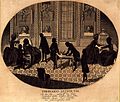Hieronymus Löschenkohl
Johann Hieronymus Löschenkohl (baptized March 18, 1753 in Elberfeld (now part of Wuppertal ), Germany; † January 11, 1807 in Vienna ) was an engraver and engraver and a successful entrepreneur in this field in Vienna.
Live and act
Löschenkohl came to Vienna from Germany in 1780 at the age of 28 and opened a shop on Hohen Markt . He started with the production of Portrait - silhouettes . These concise, almost always black and white and relatively inexpensive silhouettes were very popular at the time. Löschenkohl and his main competitor, the Vienna-based French silhouette cutter Francois Gonord, depicted large circles of “better” Viennese society with their work - artists, members of the nobility and wealthy bourgeoisie. Löschenkohl was particularly successful with portraits of famous contemporaries such as Joseph Haydn and Wolfgang Amadeus Mozart , and some of his engravings he sold up to seven thousand times. He was soon able to relocate his company to Kohlmarkt , one of the best business addresses in town.
When Emperor Joseph II. The censorship abolished and temporarily created batches of press freedom, used Löschenkohl the new possibilities and the many personal contacts he had made through his work. He was to be found at all important locations in the city, including at the imperial court. He developed his company into a production facility for the most up-to-date images possible, often at the expense of artistic quality. Brightly colored copperplate engravings showed scenes from revolutions and wars, from festivities in noble houses, from spectacular crimes and special events such as the landing of a balloon at the gates of Vienna. Scenes from the imperial house of Habsburg-Lorraine took up a large space - weddings, baptisms and deaths, patriotic comments on domestic and foreign policy; after the death of Joseph II, political content became less common.
Löschenkohl's sales rooms on Kohlmarkt were a source of optical information at a time when there was no illustrated press. People crowded here all the time to see the latest pictures. The motifs were sold as single sheets, also slightly modified and attached to fans, boxes and playing cards. Löschenkohl also produced calendars, made greeting cards popular in Vienna, sold printed wallpaper and installed board games. Not infrequently, he copied the ideas of other manufacturers and benefited in part from the import ban that applied to foreign products - there was as yet no protection for intellectual property. Löschenkohl's activities were also imitated, but he was so proficient in his field that he did not have to fear serious competition. He advertised his products in the Wiener Zeitung , where, for example, an engraving was announced that he made on the occasion of the reception of the Ambassador of Morocco to the Emperor: “Audience of the Bothschafter von Morocco with his Kaiserl. [I] Royal [I] Apostol . [ischen] Majesty & c. & c. Joseph II in Vienna on February 28, 1783. Seidi Muhamet a son of Seidi Abdullah a grandson of Seidi Ismail Sultan of Morocco, Taffilet and North Africa & c. dedicated by Hieronymus Löschenkohl ”.
In April 1959 the “ Wien Museum Karlsplatz”, the new building of the Historical Museum of the City of Vienna, opened with a special exhibition about Hieronymus Löschenkohl. In the anniversary year 2009 an exhibition of his picture production took place here again. The artistic weaknesses of these works had already been criticized by his contemporaries, and the views on the truthfulness of the current representations sometimes diverged widely. On the other hand, Löschenkohl's pictures are still shown in exhibitions and reproduced in books to illustrate the period of enlightened absolutism under Emperor Joseph II.
In 1912 in Vienna Rudolfsheim-Fünfhaus (15th district) the "Loeschenkohlgasse" was named after him.
literature
- Constantin von Wurzbach : Löschenkohl, Johann . In: Biographisches Lexikon des Kaiserthums Oesterreich . 15th part. Kaiserlich-Königliche Hof- und Staatsdruckerei, Vienna 1866, pp. 400–402 ( digitized version ).
- Reingard Witzmann: Hieronymus Löschenkohl. Photo reporter between Baroque and Biedermeier . Edition Tusch, Vienna 1978
- Monika Sommer (ed.): Hieronymus Löschenkohl. Sensations from Old Vienna , catalog for the exhibition of the same name at the Wien Museum , Christian Brandstätter Verlag, Vienna 2009, ISBN 978-3-85033-315-3
- Thomas Hubmayer: Hieronymus Löschenkohl in the context of the cultural and social history of Josephinism . Diploma thesis, University of Vienna 2012 ( full text )
Web links
- Literature by and about Hieronymus Löschenkohl in the catalog of the German National Library
- Entry on Hieronymus Löschenkohl in the Austria Forum (in the AEIOU Austria Lexicon )
- The festival in the Orangery in Schönbrun - February 7th, 1786. Etching by JH Löschenkohl
Individual evidence
- ↑ Flood of images as a recipe for success ( page can no longer be called up , search in web archives ) Info: The link was automatically marked as defective. Please check the link according to the instructions and then remove this notice. in the Wiener Zeitung of April 23, 2009 accessed on April 23, 2009
- ↑ Sensations from old Vienna on April 22, 2009, accessed on April 23, 2009
- ↑ Antiquarian & art dealer Christian M.Nebehay accessed on 23 April 2009
| personal data | |
|---|---|
| SURNAME | Löschenkohl, Hieronymus |
| ALTERNATIVE NAMES | Löschenkohl, Johann Hieronymus |
| BRIEF DESCRIPTION | Austrian painter and engraver |
| DATE OF BIRTH | baptized March 18, 1753 |
| PLACE OF BIRTH | Elberfeld |
| DATE OF DEATH | January 11, 1807 |
| Place of death | Vienna |




